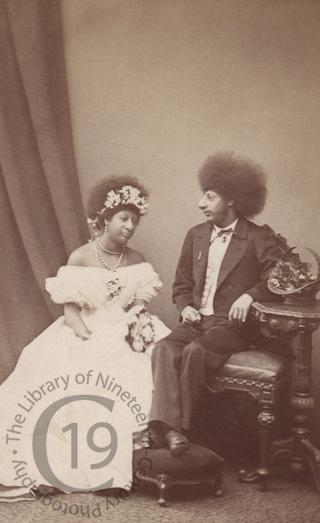
Maximo and Bartola
A carte-de-visite portrait of Maximo and Bartola, the microcephalic brother and sister who were billed as ‘The Aztec Children’ and exhibited by Barnum. They are seen here in the costumes they wore at their ‘wedding’ in 1867.
The Central American Indians Maximo and Bartola were small, childlike, curious people with a mental age of about two years; they could each speak only a few words. They had been born in Mexico to peasants, Innocente Burgos and Marina Espina and were taken from their mother by a Spanish trader named Ramon Selva, who told her that he was taking them to the United States to be ‘cured of their imbecility.’ He sold them to a man named Morris, who became their owner and manager. Eventually, they joined the family of human oddities exhibited by the great showman P.T. Barnum.
During the nineteenth century, Americans were becoming increasingly interested in the natural history of the Western hemisphere. Since recent discoveries of Meso-American artefacts depicted people with strange elongated skulls, Maximo and Bartola were billed as ‘the Aztec Children.’ They first appeared in 1849, around the same time as the ‘Wild Men of Borneo.’ According to their publicity, they were discovered in an ancient Aztec temple, perched on an altar like a pair of idols. They proved enormously popular with the public, and even among archaeologists and scientists, including Professor Richard Owen. During the 1850s they appeared before the Boston Society of Natural History and were written up extensively in the ‘American Journal of the Medical Sciences.’ They were invited to the White House to meet President Fillmore and, in England, they were summoned to Buckingham Palace. During their subsequent tour, they appeared before most of the crowned heads of Europe.
As they reached adulthood, their billing was changed from ‘The Aztec Children’ to ‘The Aztec Lilliputians’ or ‘The Last of the Ancient Aztecs’ or sometimes just ‘The Aztecs.’ In a shameless publicity stunt, they were married in London on 7 January 1867, as ‘Señor Maximo Velasquez Nunez’ and ‘Señora Bartola Velasquez.’ This was an official marriage and was duly recorded at the local register office. The wedding was allowed on the spurious grounds that Aztec custom mandated the marriage of brothers and sisters to one another. Maximo wore evening dress, and Bartola wore a white satin wedding dress. A couple of months later they were appearing at the Hanover Square Rooms (entrance 5 shillings), on the same bill as the ‘Musical Albinos.’ One could also visit them at their own residence on Hanover Street (same entrance fee) between the hours of 1 and 3 o’clock.
However, their popularity was already declining. The scientific community’s interest was drawn to more legitimate discoveries while, in the minds of the general public, other ‘pinheads’ took the spotlight as the precious survivors of lost civilizations. Maximo and Bartola’s last known appearance, apparently, was in 1901, when they were mentioned in a Barnum and Bailey route book.
Photographed by the London Stereoscopic and Photographic Company.
Code: 126357




